
FTU Working Paper Series, Vol. 2 No. 4 (10/2021) | 101
MỐI QUAN HỆ GIỮA CHIẾN LƯỢC ĐA DẠNG HÓA VÀ CÔNG BỐ
THÔNG TIN TRÁCH NHIỆM XÃ HỘI CỦA DOANH NGHIỆP NIÊM YẾT
TẠI VIỆT NAM
Thang Thùy Linh1, Lê Vũ Hà Phương
Sinh viên K57 CTTT Quản trị kinh doanh - Khoa Quản trị kinh doanh
Trường Đại học Ngoại thương, Hà Nội, Việt Nam
Nguyễn Thúy Anh
Giảng viên Khoa Quản trị kinh doanh
Trường Đại học Ngoại thương, Hà Nội, Việt Nam
Tóm tắt
Ngày nay, việc thực hiện trách nhiệm xã hội (TNXH) và công bố thông tin (CBTT) liên quan đang
nhận được sự quan tâm rất lớn từ các doanh ngiệp trên toàn thế giới, tuy nhiên, mối quan hệ giữa
CBTT TNXH và chiến lược tăng trưởng bằng cách đa dạng hóa của doanh nghiệp đang là chủ đề
hiếm khi được nghiên cứu. Đặc biệt, ở một quốc gia đang phát triển như Việt Nam, đề tài nghiên
cứu này vẫn chưa được tiến hành. Kết quả nhóm tác giả chúng tôi chỉ ra rằng chiến lược đa dạng
hóa địa lý và đa dạng hóa ngành có tác động thuận chiều tới mức độ CBTT TNXH bên cạnh những
đặc điểm doanh nghiệp như đòn bảy, lợi nhuận, quy mô và việc sử dụng đơn vị kiểm toán độc lập.
Kết quả của bài nghiên cứu không chỉ góp phần vào cơ sở lý thuyết về các nhân tố tác động đến
việc CBTT TNXH của doanh nghiệp mà còn đề xuất các giải pháp cho doanh nghiệp nhằm tăng
cường minh bạch thông tin về phát triển bền vững tại Việt Nam và trên thế giới.
Từ khóa: Trách nhiệm xã hội, Công bố thông tin, Chiến lược đa dạng hóa, Đa dạng hóa địa lý,
Đa dạng hóa ngành.
THE RELATIONSHIP BETWEEN DIVERSIFICATION STRATEGY AND
CORPORATE SOCIAL RESPONSIBILITY DISCLOSURE OF
VIETNAM LISTED COMPANIES
Abstract
Despite the increasing attention on corporate social responsibility disclosure (CSRD) over the
world, the relationship between CSRD and a common form of growth strategy known as
diversification has been rarely examined. Especially in a developing country like Vietnam, this
research topic has not been conducted yet. Aside from showing positive influence of firms’
characteristics such as leverage, profitability, broad size and audit firms on corporate social
responsibility (CSR) reporting, the findings indicate that geographical and industry diversification
1 Tác giả liên hệ, Email: linhtthang07@gmail.com
Working Paper 2021.2.4.07
- Vol 2, No 4

FTU Working Paper Series, Vol. 2 No. 4 (10/2021) | 102
is significantly and positively related to the extent of CSRD. By introducing new independent
variables into the CSRD research topic in Vietnam, this paper is expected to extend the scope of
earlier studies. It will enrich current knowledge of determinants of CSRD and propose several
implications for enterprises to improve the sustainability development disclosure in Vietnam
context specifically or over the world in general.
Keywords: Corporate social responsibility (CSR), CSRD, Diversification strategy, Segment
diversification, Geographical diversification.
1. Introduction
In the contemporary corporate world, concern for corporate social responsibility (CSR) has
become a key component of significant success. In that context, people expect the organizations
to go beyond the legal or regulatory requirement to invest more into human capital, environment,
and stakeholder relations, as well as to engage in social or environmental behavior that makes a
great contribution to society (Kitzmueller & Shimshack, 2012).
Recently, CSRD is receiving increasing attention from the mainstream accounting research
community, thus there have been a lot of studies examining the determinants that affect CSR
transparency. A study by Ali, Frynas and Mahmood (2017) found that the degree of CSRD is
influenced by both company characteristics and environmental factors. However, the specific
impact of an internal factor known as diversification strategy has been a topic of scare examination,
especially in a developing country like Vietnam.
Diversification is commonly recognized as an important growth tactic for businesses to gain
market share, build brand loyalty, and boost overall market performance. In diversification strategy,
geographic diversification and industry diversification have been identified as the two dominant
development techniques (Caves, 1996; Mudambi, 2002). Industry diversification is described as
“entry into a new product market activity implying a considerable increase in the available
managerial competence within the firm” (Rumelt 1974). Meanwhile, geographical diversification is
the expansion of a business’s operations into multiple locations (Lu & Beamish, 2004).
Firms operating in industries characterized by low profitability and few opportunities,
according to Stimpert and Duhaime (1997), tended to expand by entering into new businesses. In
1981, Christensen and Montgomery presented evidence to claim that diversification was a means
to escape from the poor profitability of the firm’s industry. Additionally, introducing businesses
to more regions and people provides opportunities for the companies to establish brand recognition
(Lu & Beamish, 2004). With those advantages of diversification to the firms’ performance, a
growing number of companies from various industries are opting for diversification as their
primary strategies for the growth paths.
Due to their crucial roles in modern businesses as well as their positive effects on firms’
sustainable development, both diversification strategy and CSRD have been receiving growing
recognition from corporate stakeholders and the community. However, the relationship between
them has not been officially examined, especially in the Vietnamese context. As a result, this study
is going to delve into a relatively new area with the main purpose to identify whether there are any
relationships between the diversification strategy (product and regional diversification) and CSRD
in Vietnamese publicly listed corporations.

FTU Working Paper Series, Vol. 2 No. 4 (10/2021) | 103
As a study of CSRD in Vietnam, this proposal will add to a scarce source of research on CSR
in emerging economies. The findings of this paper will aid in the interpretation of CSRD
determinants and provide insights to enhance the application and execution of disclosure
guidelines. Additionally, the paper will support both internal and external stakeholders in
determining the characteristics of the strategies of the companies via their publication of CSR
reports. The result is expected to assist the Vietnamese corporates in applying the relationship
between the two components in developing strategies that are appropriate with their current
conditions, thus ensuring sustainable growth. Finally, this dissertation can serve as a foundation
for future studies to develop new findings in the fields relating to diversification strategies, CSR
reporting, or corporate transparency in general.
The study proceeds as follows: Firstly, the authors identify research background, research
rationale, research objective, and scopes in which the research is conducted and develop the
hypotheses. Secondly, in the methodology section, the authors describe the data collecting process
and models used to measure variables and to test the proposed hypotheses. The last sections define
what results can be obtained and discuss the results’ implication before concluding the study by
some limitations when conducting the research. In this section, the study also provides some
recommendations for future dissertations and gives suggestions for practical application in a real-
life situation.
2. Literature review
2.1. Corporate social responsibility disclosure
CSR disclosure practices include the reporting of any information concerning the
responsibilities of firms for their impact on society, such as moral obligations or the ethical
activities in which firms have engaged to minimize harm to the community, environment,
employees, and consumers (Lee & Cassell, 2008, Vu & Buranatrakul, 2018). Existing scholars
have conducted intensive studies on the features of CSR and on the factors influencing CSR
practices of businesses. While some articles concentrate on corporate governance characteristics
such as board independence, board size, CEO duality, government ownership, audit committee
(Said et al., 2009, Haniffa & Cooke, 2005; Ghazali, 2007), many other papers explore what kinds
of company-specific characteristic variables, such as firm scale, media attention, environmental
sensitivity, profitability, and firm age, would affect corporate social responsibility disclosures
(Roberts, 1992; Cowen, 1987). For example, using stakeholder theory as a basis, Robert (1992)
proposed that the greater a company's economic success in previous years, as determined by
growth in return on equity, the higher its existing levels of corporate social responsibility
disclosures. Meanwhile, Wang, Song and Yao (2013) discovered that firm size, ownership
concentration, institutional shareholding, and media exposure are positively and significantly
related to the levels of various corporate social responsibility disclosure indicators, and that firms
in environmental sensitivity industries disclose more CSR information related to environmental
protection improvement, while firms in consumer sensitivity industries disclose less CSR
information related to their industries. Despite the fact that CSR disclosure is not a new practice
in developed economies (Vu & Buranatrakul, 2018), it is still an alien concept in Vietnam (Hamm,
2012). According to Nguyen and Truong (2016), the perception of CSR in Vietnam remains vague,
and its implementation is limited. Overall, it can be concluded that the study and practice of CSR
reporting in Vietnam have been insignificant in the past (Vu & Buranatrakul, 2018).

FTU Working Paper Series, Vol. 2 No. 4 (10/2021) | 104
2.2. Geographic diversification
Geographic diversification is a significant determinant of numerous phenomena and
challenges in both economics and finance. Researchers have shown that geographic dispersion
affects firm economic performance, firm valuation, stock returns, innovation, systematic risk,
corporate decision making, and especially corporate social performance (Shi et al., 2017; Kim &
Mathur, 2008). Kim and Mathur, using a dataset of 28,050 firm-year observations from 1990 to
1998, discovered that geographic diversification is associated with a decrease in firm value and
that the costs of corporate diversification may outweigh the benefits of diversification. Shi et al.
(2017) reveal that geographic diversification is strongly and negatively correlated with CSR
ratings, and they use three reasons to justify these negative relationships: social engagement,
agency cost, and consumer and investor recognition.
2.3. Industry diversification
Geographical and industry diversification are conventional corporate techniques that
companies apply as they aspire to grow their business. Over the last decade, an extensive academic
literature has developed investigating the causes and effects of industrial diversification (Denis,
Denis & Yost, 2002), as well as their association with geographical diversification, corporate
performance in terms of finance, society, and firm valuation (Mayer, Stadler & Hautz, 2014; Denis,
Denis & Yost, 2002). In 2002, as Jingoo Kang was surprised with the exclusive focus of the
existing diversification - corporate social performance literature on international diversification
instead of both geographical and industry diversification, he conducted the research and
discovered a favorable association between unrelated product diversification and corporate social
performance. Meanwhile, related product diversification was found not to have a meaningful
relationship with CSP. Today, we experience the same situation but in terms of corporate social
responsibility disclosure as there has been very little research relating industry diversification to
CSRDs Sambharya (2018) and the support for this relationship is largely missing.
2.4. Diversification strategy and corporate social responsibility disclosures
According to Freeman (1984), a stakeholder is "any group or individual who can affect or
is affected by the achievement of the firm's objectives”. The behavior and demand of customers,
who are significantly important stakeholders, is a critical factor that companies must consider
when developing corporate strategies, and diversification strategy is no different. Robin W.
Roberts published a study in 1992 trying to understand the determinants of CSRDs using
stakeholder theory. The proxies selected to represent the influences of stakeholder power on
corporate social responsibility disclosures are the power of stockholders, creditors and
legislative bodies (Roberts, 1992).
The paper of Roberts in 1992 had revealed that companies that confront a higher degree of
political scrutiny are more likely to report their social responsibility initiatives. It also supports the
contention that management can interpret social responsibility disclosures as a way to satisfy
different creditor stakeholder expectations. Although stakeholder theory can act as a bridge to
clarify the relationship between diversification policy and CSRDs, there are far too few studies
that specifically investigate the effect of diversification strategy on firms’ CSRDs, especially in
emerging economies. As a result, we attempt to fill the study void by investigating the impact of
diversification policy on corporate social practices disclosure of Vietnamese listed companies.

FTU Working Paper Series, Vol. 2 No. 4 (10/2021) | 105
3. Hypothesis development
As mentioned above, despite the lack of empirical dissertations directly investigating the
connection between diversification strategy and CSRD, there is a wide range of studies focusing
on CSR initiatives, CSRD and diversification separately that are extremely helpful in laying a solid
foundation for developing this research’s hypotheses.
We can expect a positive linkage between regional diversification and CSRD based on social
and political theories such as institutional, legitimacy and stakeholder theory. The institutional
theory “considers the processes by which structures, rules, norms and routines become established
as authorities as authoritative guidelines for social behavior” (Scott, 2007). Hoffman (2001) stated
that “the form of organizational response reflects the institutional pressures that emerge from
outside the organization”.
According to stakeholder theory as mentioned in the literature review section, a firm’s ability
to manage different stakeholder groups significantly influences stakeholder satisfaction (Sangle,
2010). Sustainability disclosure - a part of stakeholder management (Adams, 2002), plays a critical
role in creating and maintaining the interaction between the organization and its stakeholder.
Basically, the more sustainability disclosure is performed, the higher customers’ satisfaction levels
are, then the enterprise has a higher chance to achieve greater success. (Amran et al., 2013).
Briefly, when a company expands its business into multiple countries, it has to deal with
institutional pressures from different governments, and needs to satisfy diverse groups of
stakeholders, which leads to increasing requirements for the firm’s information disclosure,
especially information relating to social and environmental responsibility.
Hypothesis 1 (H1): Geographical diversification is positively associated with CSRD extent.
In terms of segment diversification, Kang (2002) found a positive relationship between
unrelated industry diversification and CSR performance. Similarly, Xu & Liu (2017) stated that a
higher level of industry diversification led to a higher level of engagement and more performance
in CSR, especially in the case of unrelated product diversified-companies. In addition, global
customers prefer companies that have strong social images or have a good reputation for
environmental responsibilities (CSR Europe, 2007) while a constructive relationship exists
between brand name and voluntary disclosure (Haddock and Fraser, 2008; Haddock & Tourelle,
2010). For a product diversified firm, having a good social reputation is one of the key components
to attract and sustain customers. In this context, brand equity can be established by the company’s
performance of socially responsible activities and its reporting sustainable information. Therefore,
it leads to our second hypothesis:
Hypothesis 2 (H2): Industry diversification is positively associated with CSRD extent.
4. Methodology
This research uses the secondary quantitative approach, which employs secondary data from
annual consolidated financial reports of listed Vietnamese companies operating in a variety of
industries such as banking, engineering, medical, aquaculture, construction, chemical, tourism,
etc. We gathered information about these businesses from their annual financial reports from 2016
to 2018. The data pertaining to the calculation of independent variables is gathered from the
“segment reporting” section. However, since many businesses do not provide segment reporting

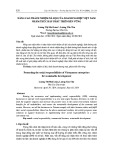
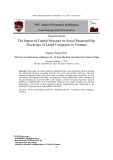
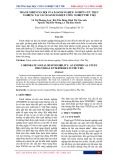
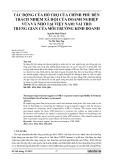
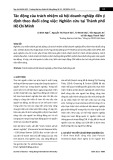
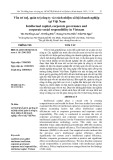
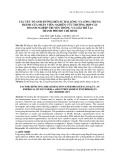
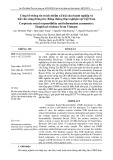
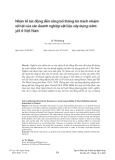
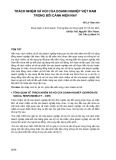


![Đề thi kết thúc học phần môn Truyền thông trong kinh doanh [năm học mới nhất]](https://cdn.tailieu.vn/images/document/thumbnail/2025/20251015/dilysstran/135x160/93281760499390.jpg)


![Bài tập nhóm truyền thông marketing tích hợp [mới nhất]](https://cdn.tailieu.vn/images/document/thumbnail/2025/20250904/hakanami1502@gmail.com/135x160/90671756969236.jpg)





![Định vị doanh nghiệp: Bài thuyết trình [Mới nhất]](https://cdn.tailieu.vn/images/document/thumbnail/2025/20250813/vuthuhuyen1407/135x160/6261755072381.jpg)



